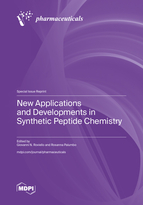New Applications and Developments in Synthetic Peptide Chemistry
A special issue of Pharmaceuticals (ISSN 1424-8247). This special issue belongs to the section "Biopharmaceuticals".
Deadline for manuscript submissions: closed (30 May 2023) | Viewed by 30940
Special Issue Editors
Interests: peptide chemistry; solid phase synthesis; solution synthesis; nucleopeptides; PNA; nucleic acid chemistry; spectroscopic studies; SARS-CoV-2 and MERS-CoV coronaviruses; computational studies
Special Issues, Collections and Topics in MDPI journals
Special Issue Information
Dear Colleagues,
Peptide-based therapeutics are of great relevance in biomedicine for the treatment of pathologies of enormous social impact, including cancer, neurodegeneration, and viral diseases, like the current COVID-19 pandemic. In this context, peptide inhibitors of SARS-CoV-2 enzymes are under investigation in the fight against the novel coronavirus. Peptides are able to interact with biomacromolecules involved in crucial biological pathways such as proteins and nucleic acids. Moreover, after functionalization by DNA nucleobases, they become powerful tools in DNA and RNA targeting, as testified by the scientific literature on peptide nucleic acids (PNAs) and nucleopeptides, with known diagnostic and therapeutic potential. Nonetheless, peptide analogues of a different nature are endowed with self-assembly properties at the origin of supramolecular assemblies and nanomaterials, which are attracting increasing attention in nanomedicine and biotechnology. In this Special Issue, we wish to focus on the novel experimental and theoretical approaches for peptide design and development, with particular attention being paid to the solid phase synthesis of natural peptides, PNA, nucleopeptides, peptoids and more general peptide analogs. However, contributions to the solution synthesis of amino acid monomers as building blocks for peptide chain elongation, as well as peptide-nucleic acid and peptide–protein interaction, peptide aggregation, nucleoamino acid and nucleopeptide chemistry, peptide–metal complexes and antimicrobial poly-amino acids are also welcome, as they could improve overall knowledge with regard to the amino acid-based chemistry at the interface between peptide design and pharmaceutical applications. Other themes of interest are inherent to the computational chemistry applied to peptide science.
This Special Issue is open to the submission of both original articles and reviews that describe research and ideas on themes treated in this issue for new applications and developments in synthetic peptide chemistry.
Dr. Giovanni N. Roviello
Dr. Rosanna Palumbo
Guest Editors
Manuscript Submission Information
Manuscripts should be submitted online at www.mdpi.com by registering and logging in to this website. Once you are registered, click here to go to the submission form. Manuscripts can be submitted until the deadline. All submissions that pass pre-check are peer-reviewed. Accepted papers will be published continuously in the journal (as soon as accepted) and will be listed together on the special issue website. Research articles, review articles as well as short communications are invited. For planned papers, a title and short abstract (about 100 words) can be sent to the Editorial Office for announcement on this website.
Submitted manuscripts should not have been published previously, nor be under consideration for publication elsewhere (except conference proceedings papers). All manuscripts are thoroughly refereed through a single-blind peer-review process. A guide for authors and other relevant information for submission of manuscripts is available on the Instructions for Authors page. Pharmaceuticals is an international peer-reviewed open access monthly journal published by MDPI.
Please visit the Instructions for Authors page before submitting a manuscript. The Article Processing Charge (APC) for publication in this open access journal is 2900 CHF (Swiss Francs). Submitted papers should be well formatted and use good English. Authors may use MDPI's English editing service prior to publication or during author revisions.
Keywords
- Peptides
- Amyloid
- Alzheimer’s disease
- Parkinson’s disease
- Neuropeptides
- Peptide inhibitors
- Antiviral peptides
- Anti-COVID-19 peptides
- Peptide aggregation
- Polyamino acids
- Synthetic antivirals
- Anticancer peptides
- Peptide synthesis
- Peptoids
- PNA
- Nucleopeptides
- Nucleoamino acids
- Peptide supramolecular materials
- Peptide–-metal complexes
- Peptide characterization
- Solid phase peptide synthesis








